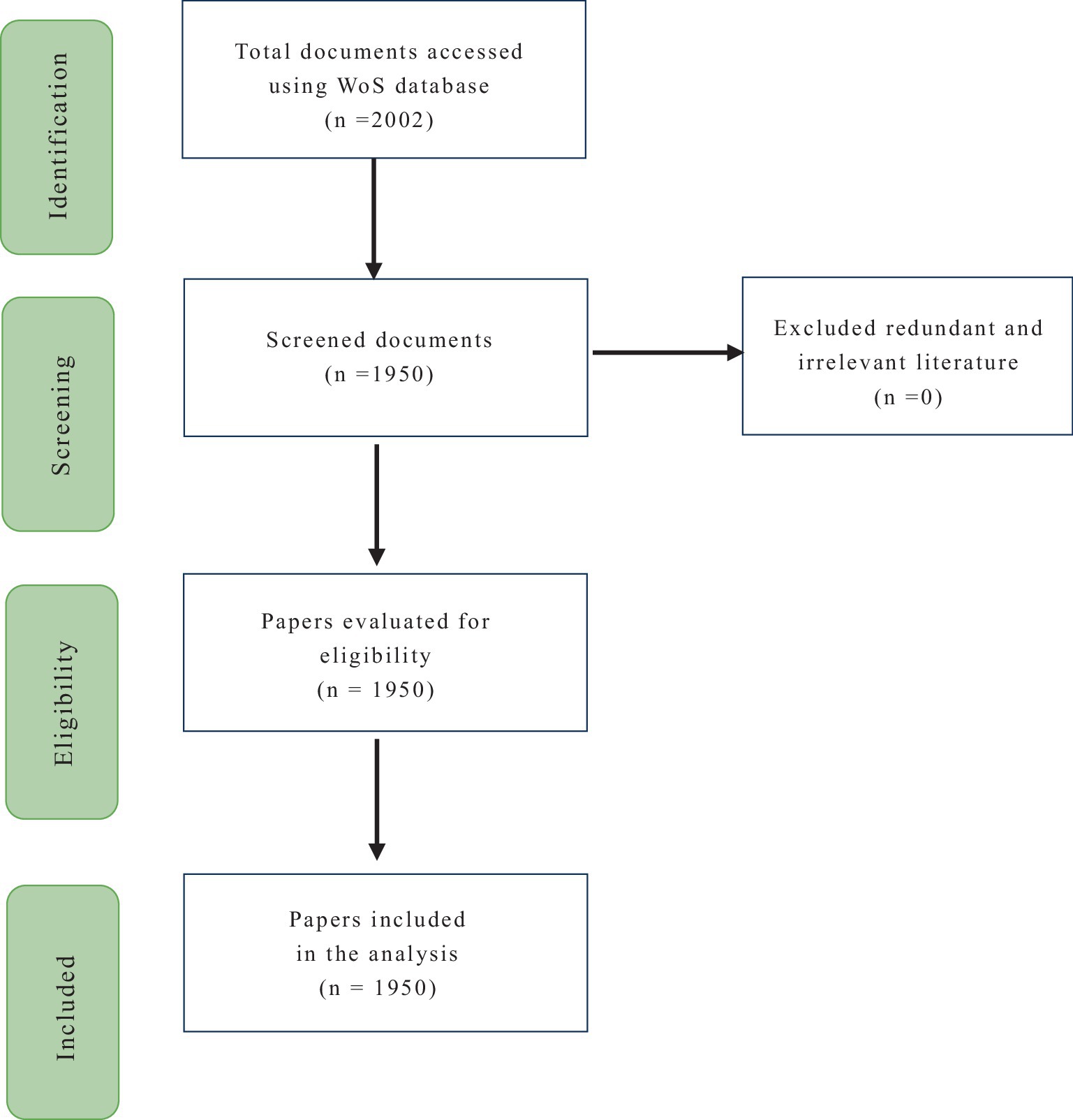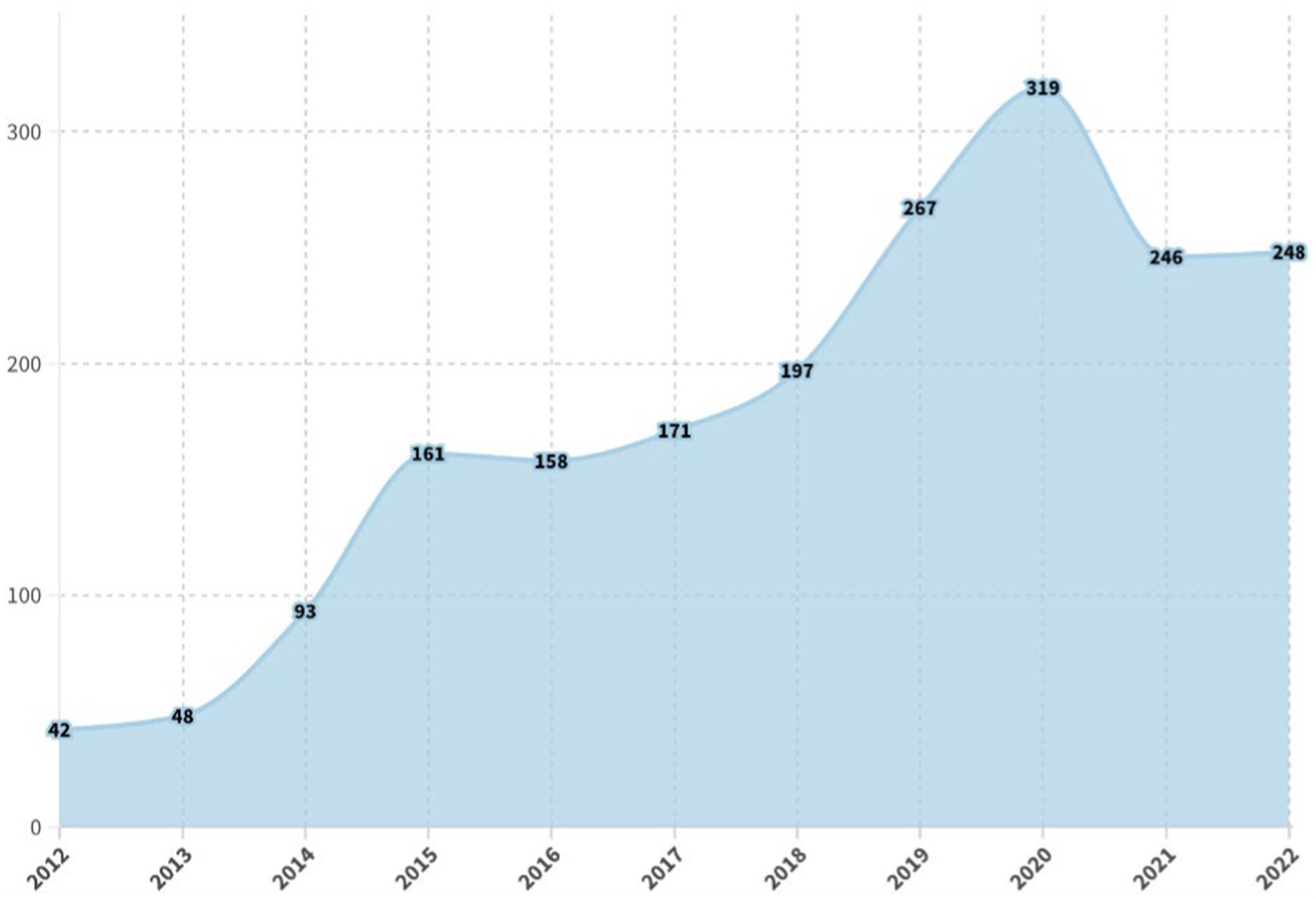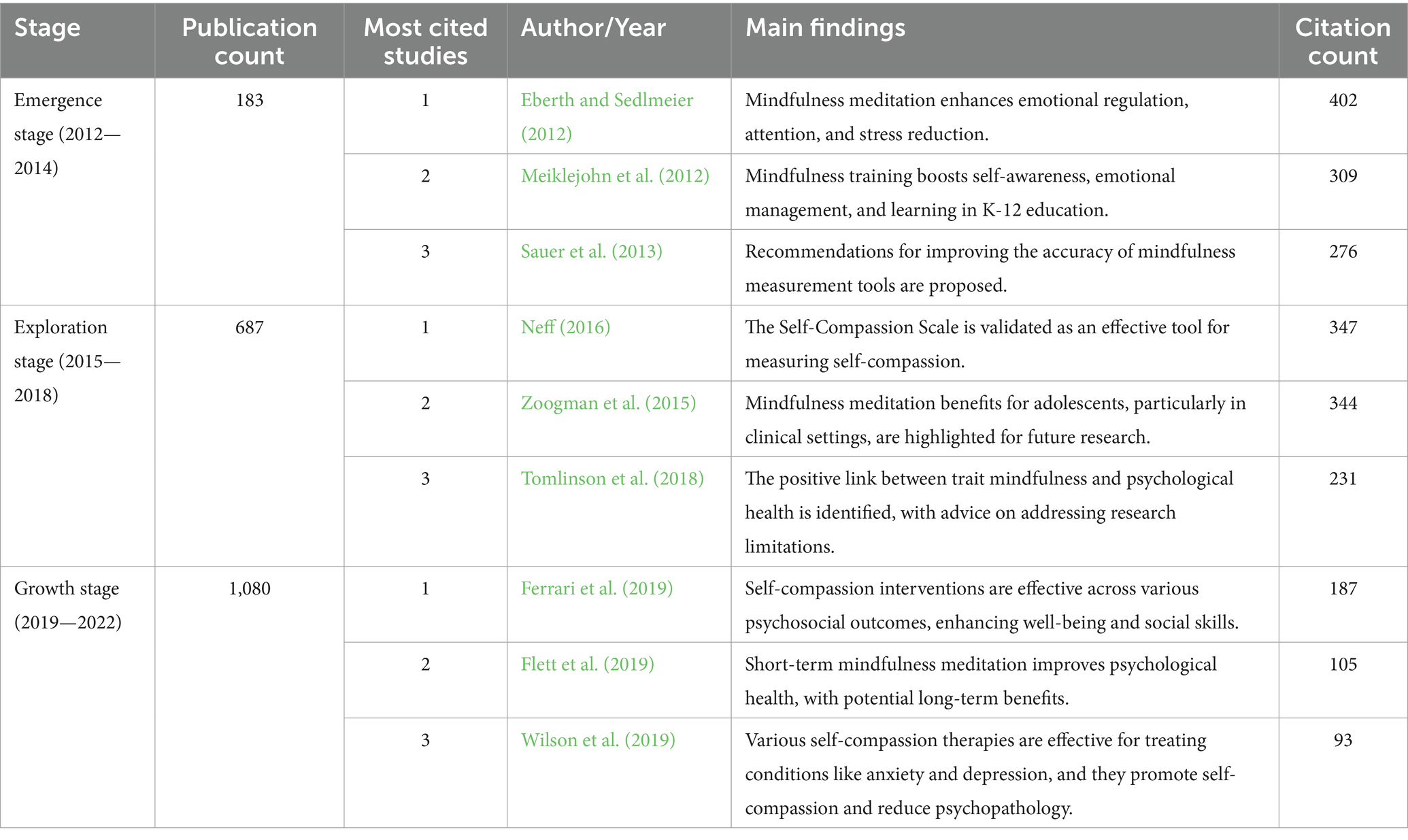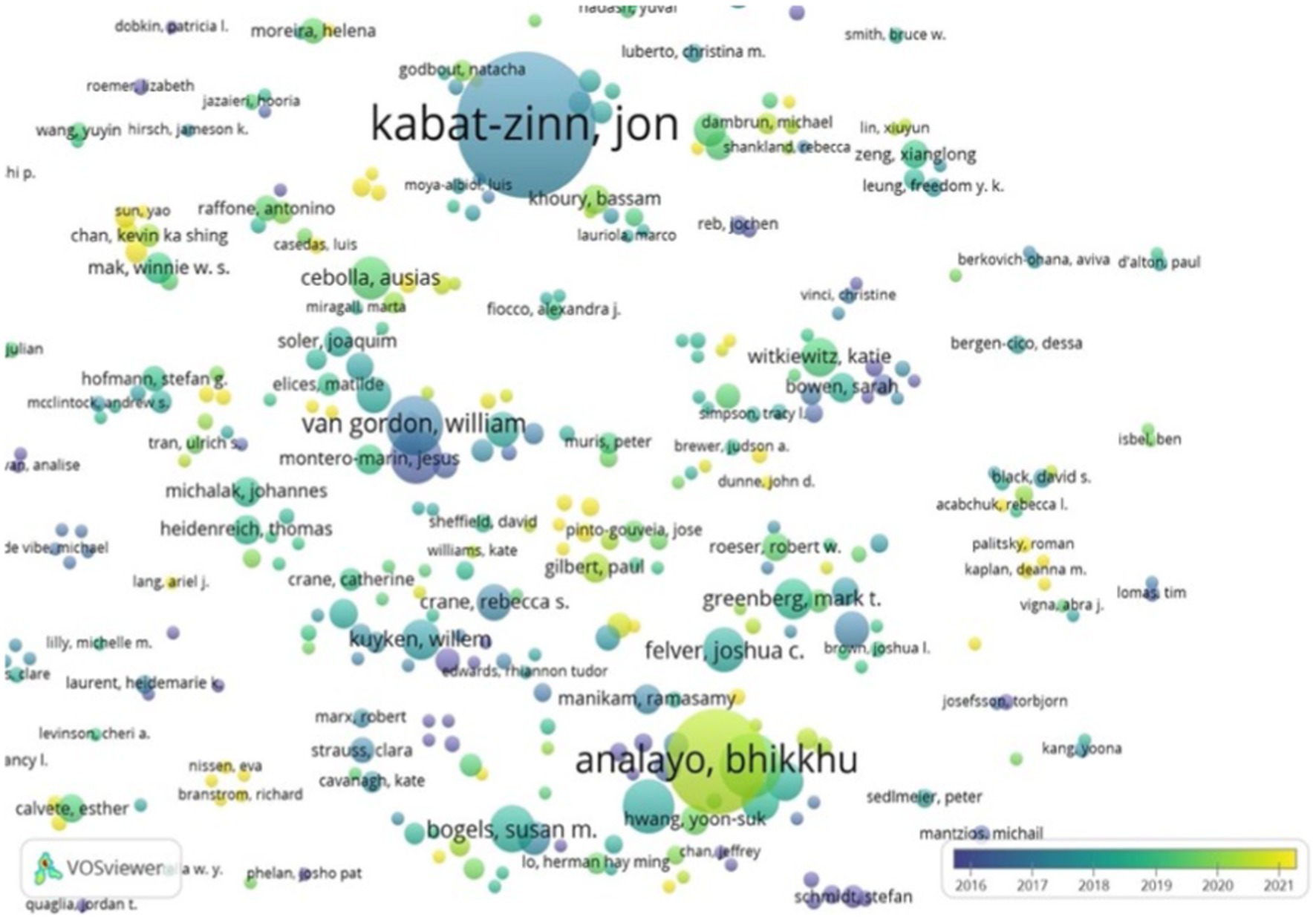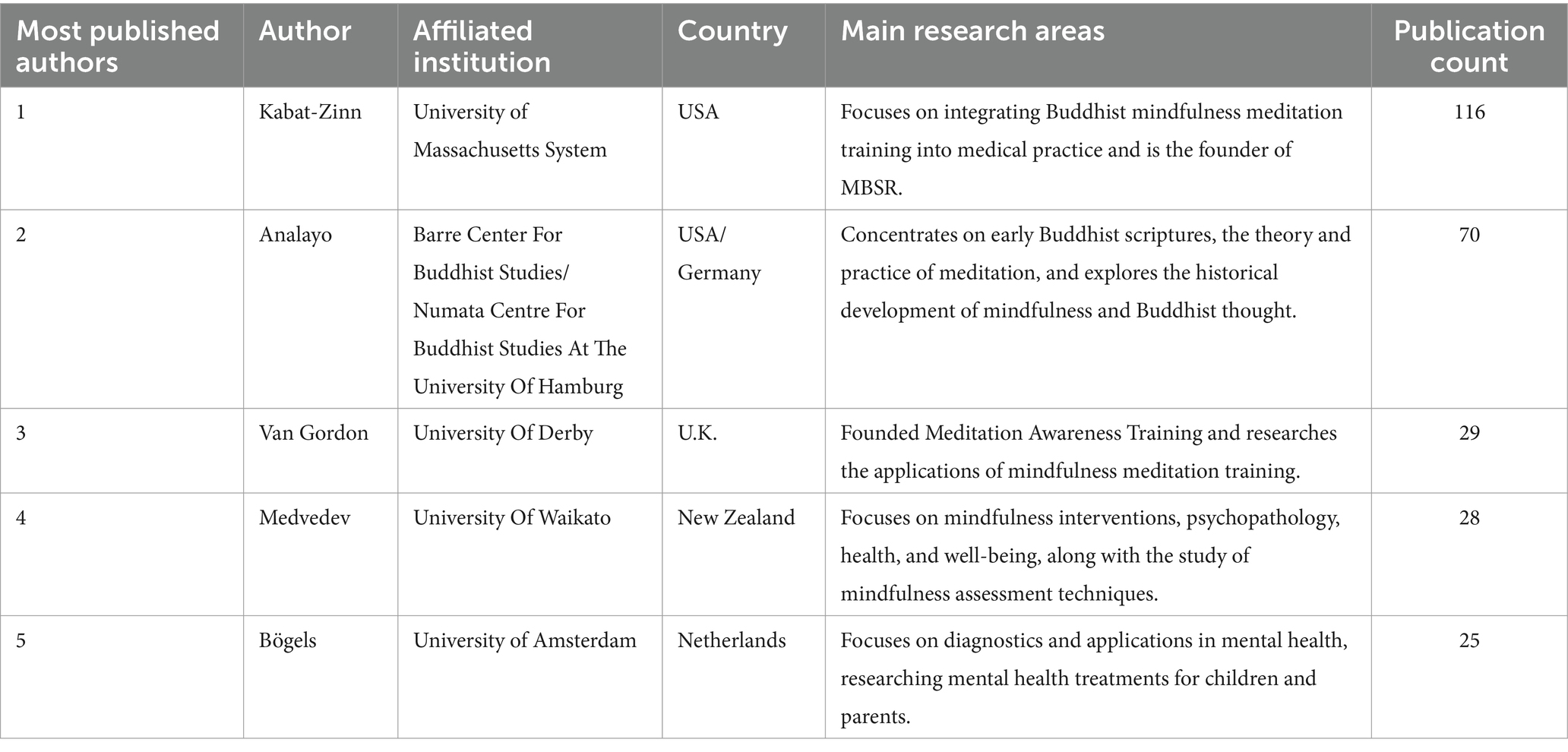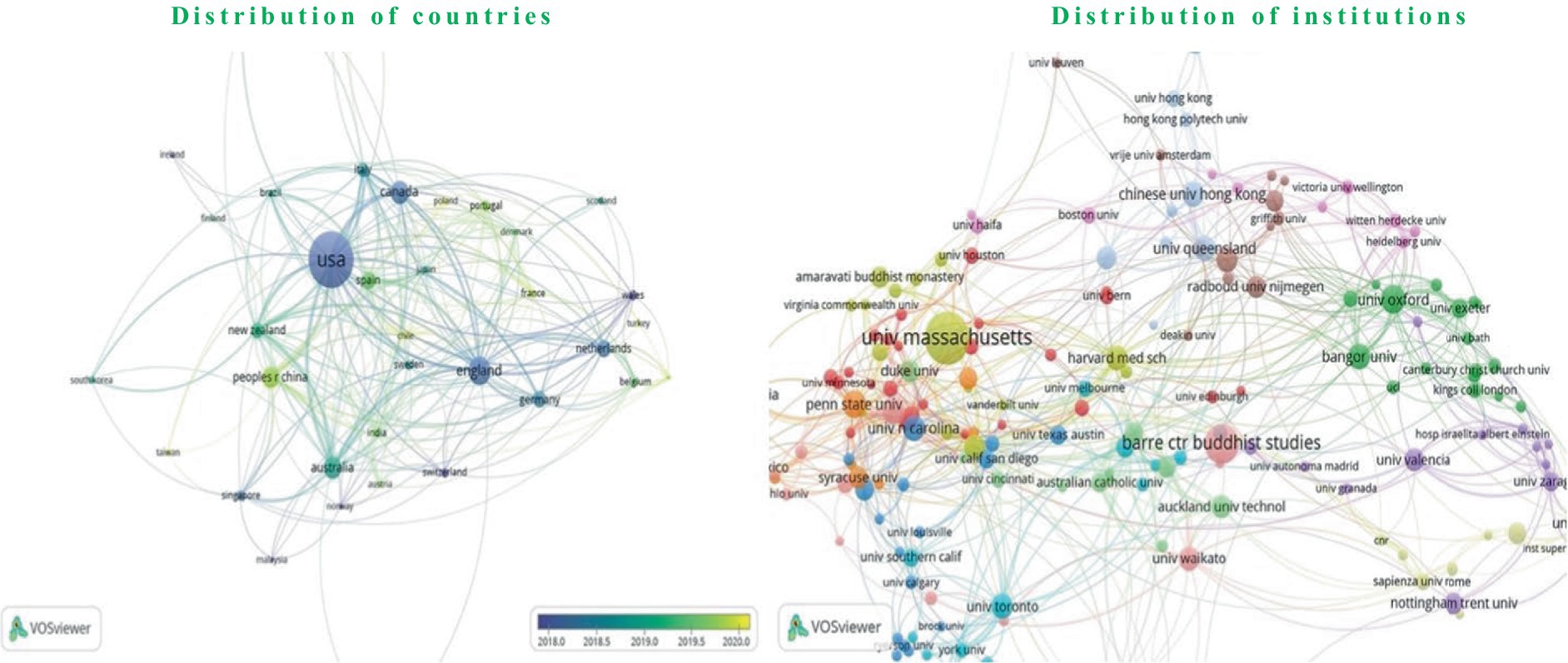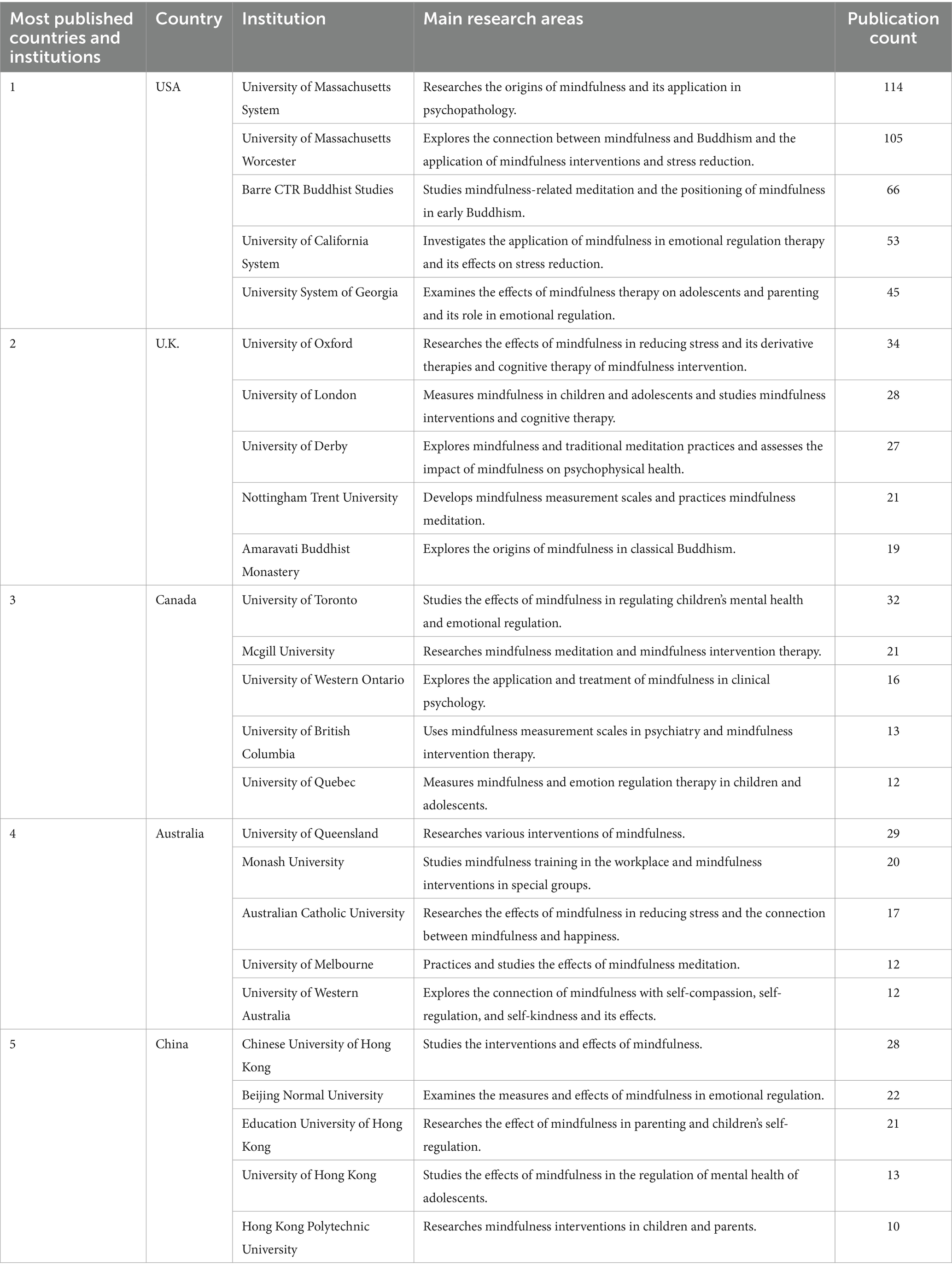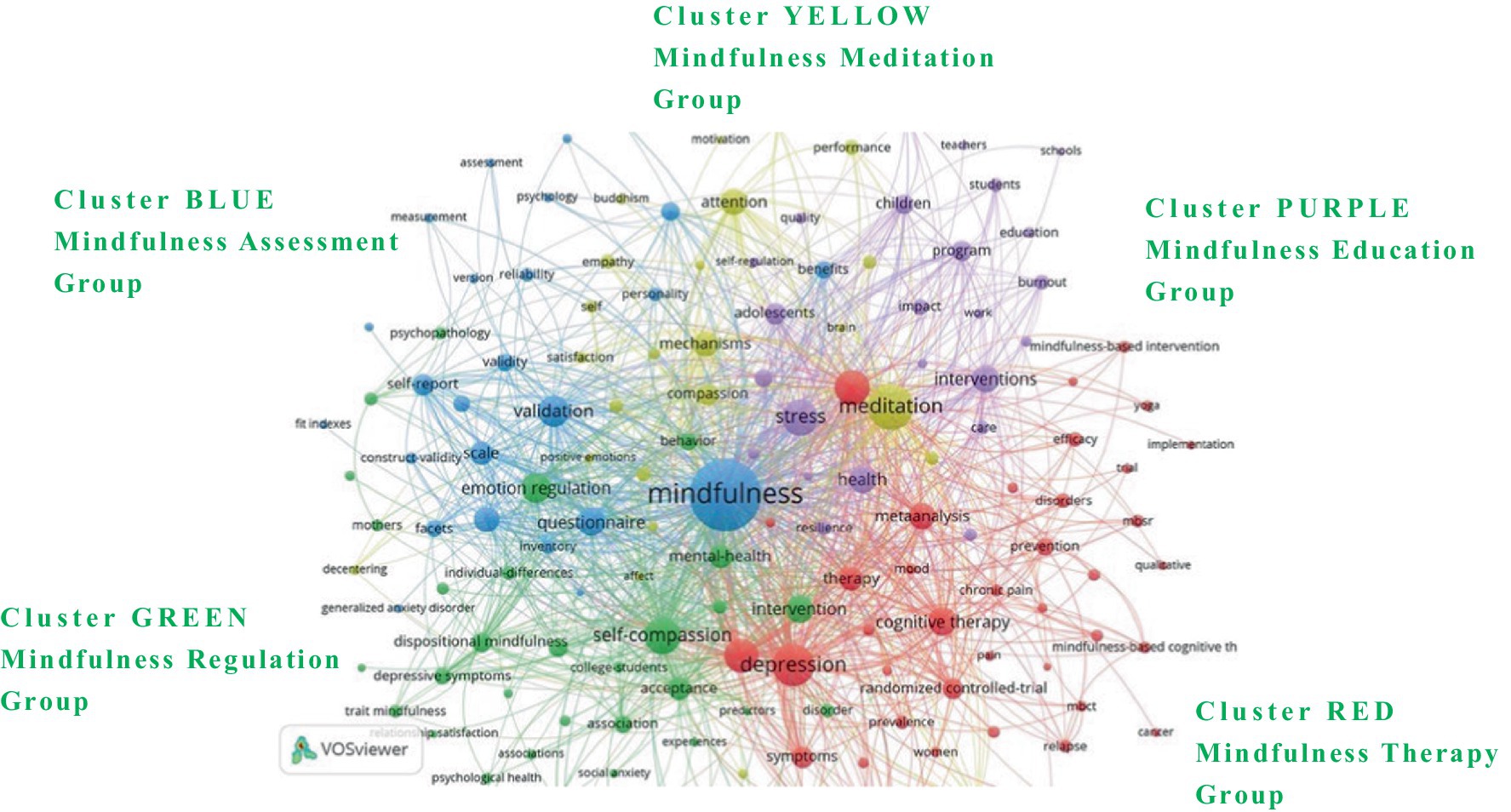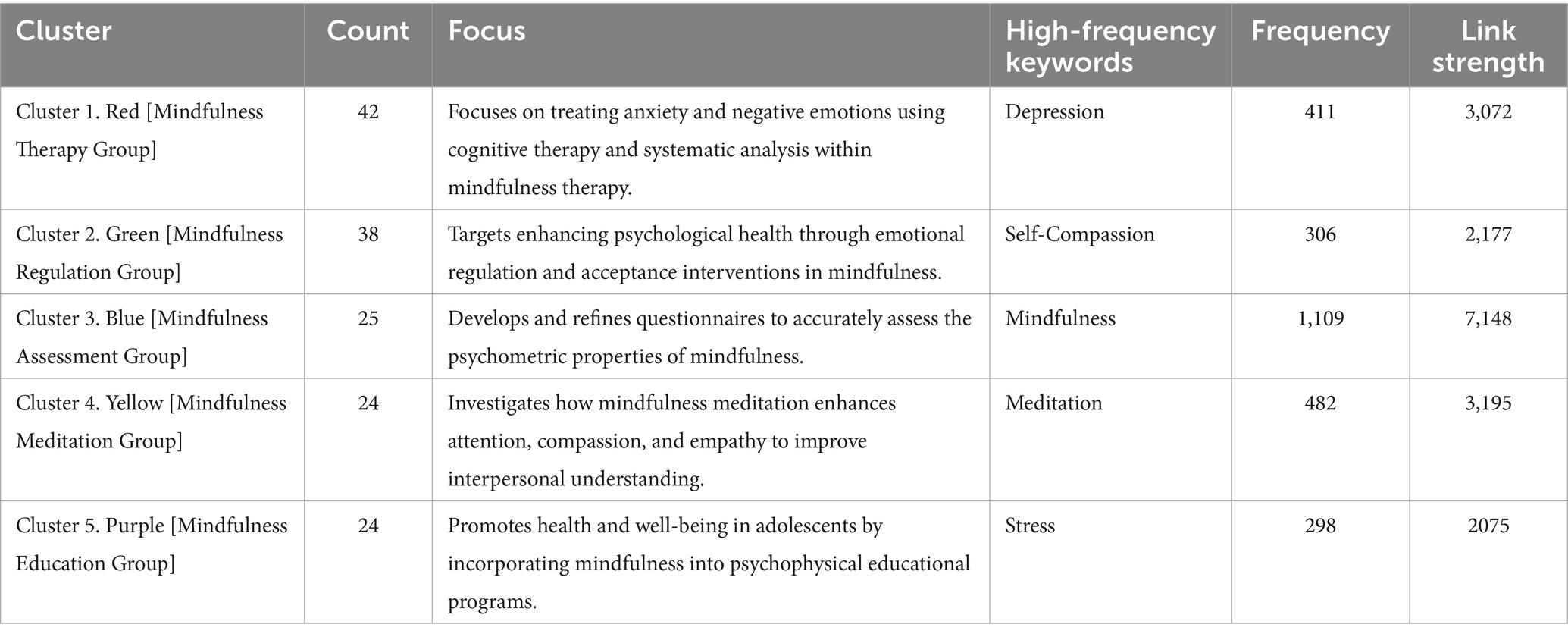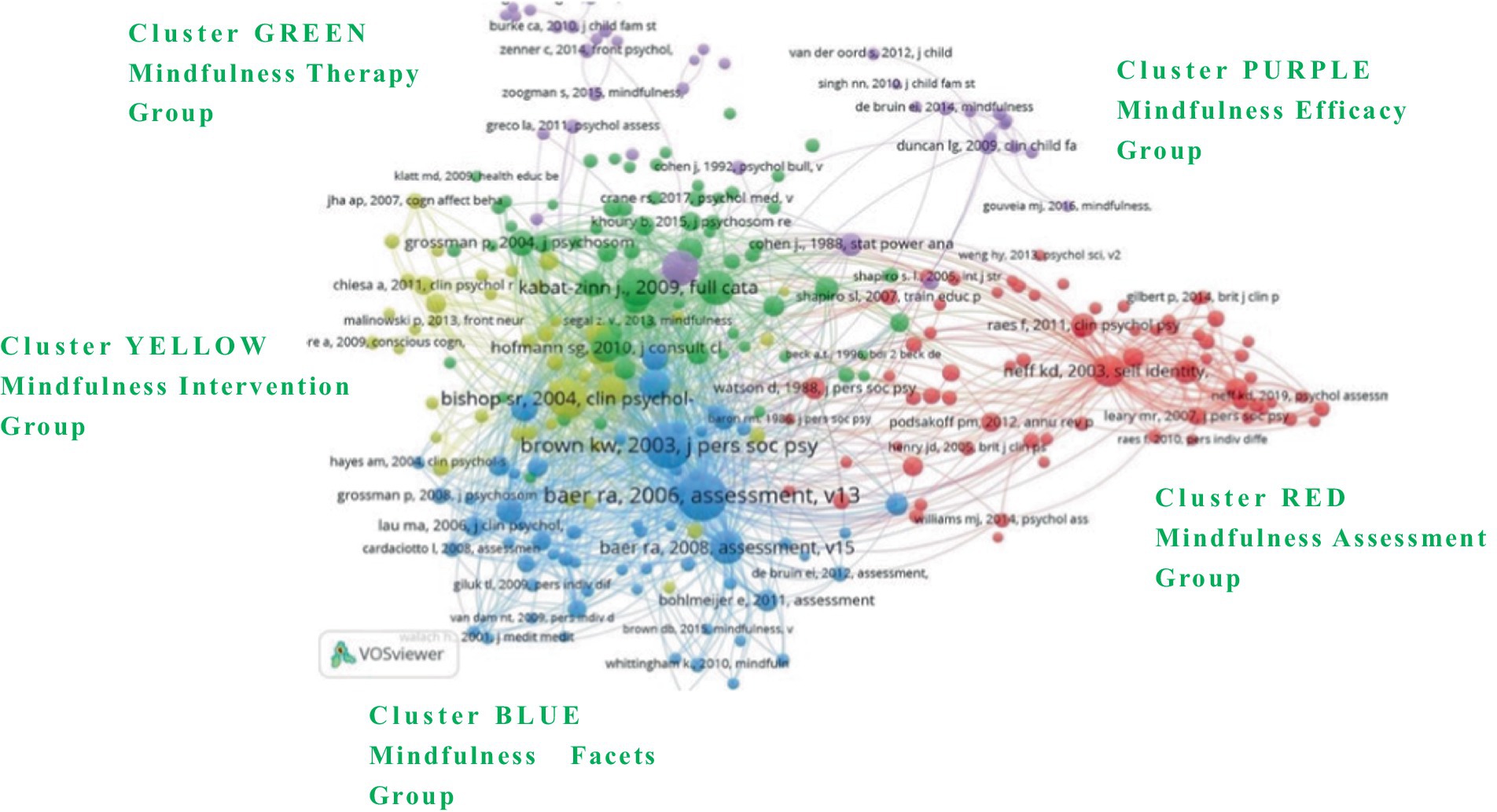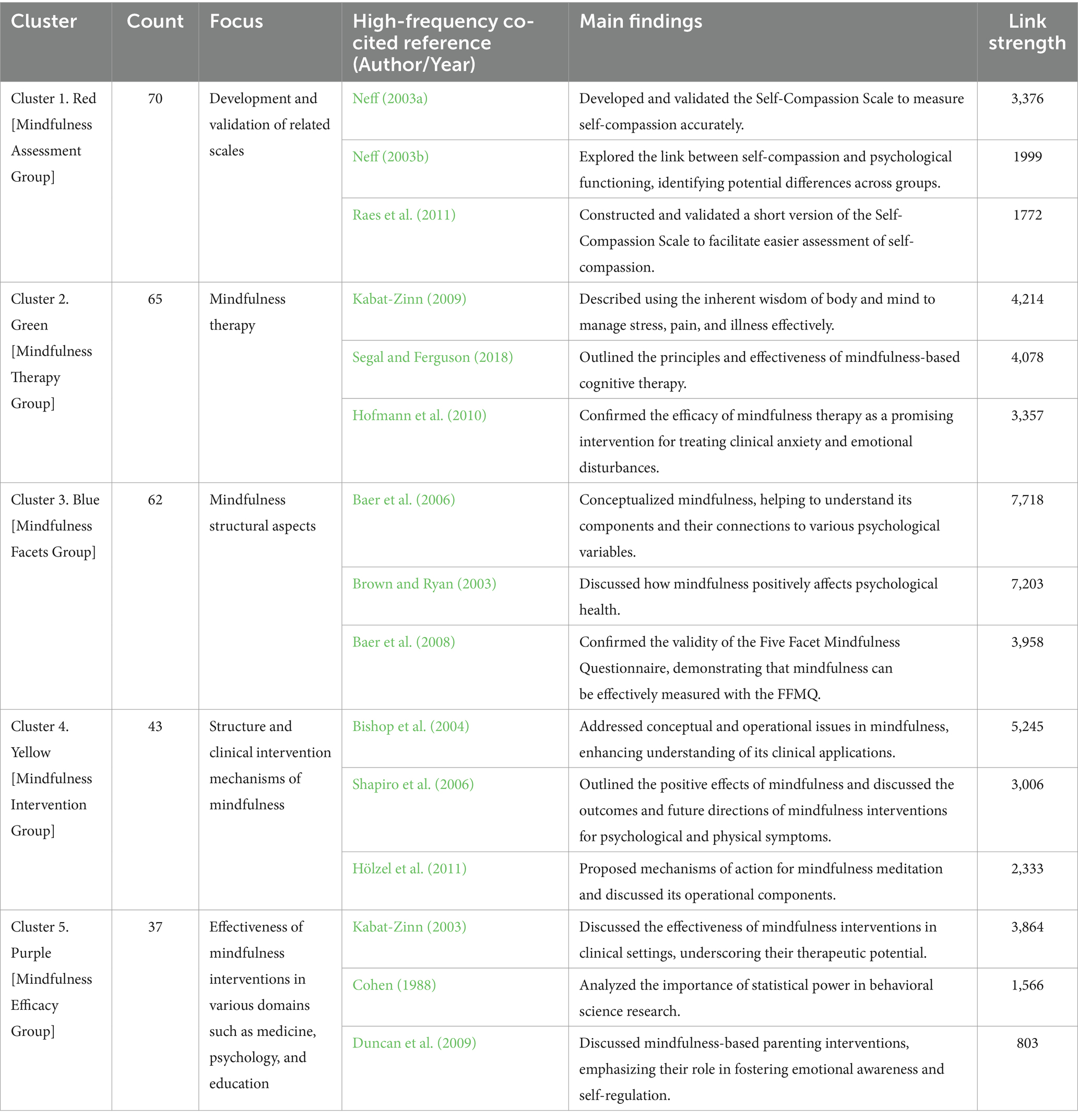- Department of Education and Learning Technology, National Tsing Hua University, Hsinchu, Taiwan
This study conducts a bibliometric analysis using the Web of Science database on 1,950 articles published in the journal Mindfulness from 2012 to 2022. By constructing a knowledge graph, the research delineates the evolution, stages of development, and emerging trends in the field of mindfulness. Significant growth in the annual publication volume has been observed since 2012, with the research progression segmented into three distinct phases. The United States has emerged as a pivotal contributor to the field, dominating in terms of publication volume, researcher involvement, and institutional contributions. Through the application of keyword co-occurrence and reference co-citation analysis, five principal clusters were identified, focusing on mindfulness, meditation, depression, stress, and self-compassion, underscoring these as focal research areas. Furthermore, the exploration of mindfulness within the educational sphere in Taiwan is still nascent, signaling a critical need for bolstered research support in diverse thematic domains.
Introduction
Mental health, a cornerstone of contemporary society, substantially influences national productivity and interpersonal relationships. Recent advances in mindfulness research suggest that cultivating mindfulness fosters positive and resilient attitudes towards evolving social contexts. Kabat-Zinn’s pioneering work in 1979 integrated Buddhist mindfulness meditation into the medical realm, inaugurating Mindfulness-Based Stress Reduction (MBSR) clinics—a milestone in healthcare applications of mindfulness (Wen, 2016).
As research into mindfulness has deepened, its applications have broadened from medicine to fields such as psychology, education, business, and even commercialization (Wilson, 2014). Empirical studies indicate that mindfulness enhances self-acceptance, care, and courage, which in turn uplifts the quality of life (Dobkin and Zhao, 2011). Additionally, it mitigates symptoms of stress, depression, and anxiety, bolsters positive emotions, and improves psychological health (Keng et al., 2011; Lakhan and Schofield, 2013; Penman and Burch, 2013). It also positively impacts attention and emotional regulation (Wen, 2013), and strengthens interpersonal relationships (Grossman et al., 2004; Davis and Hayes, 2011). As a holistic approach to psychological and physical well-being, mindfulness education encourages students to deepen their reflective thinking, enhance awareness, and apply mindfulness practices, thus continually advancing their academic and health outcomes. For instance, Napoli et al. (2005) observed that mindfulness improves children’s selective attention, mental health, and cognitive functions, enhancing overall well-being. Mindfulness interventions have also been shown to mitigate depressive symptoms in adolescents (Raes et al., 2014; Kallapiran et al., 2015) and to enhance cognition, academic performance, behavior, and socio-emotional qualities among primary and secondary students (Maynard et al., 2017). Hsieh (2018) advocates for the integration of mindfulness into school education and management, aiming to foster a comprehensive understanding of life’s significance, the pursuit of meaningful values, and the promotion of care and social responsibility.
In Taiwan, mindfulness research, albeit more recent, focuses on enhancing attention, body and mind awareness, emotional processing, and stress regulation through mindfulness practices, or explores its benefits in physical and mental health, professional development, and patient care (Chen et al., 2019). Thus, it is necessary for Taiwan to further expand the application domains of mindfulness research and to support its development through government policies, as well as to strengthen interdisciplinary collaborations to deepen the understanding of mindfulness effects across various groups. For example, Jin and Liu (2017) implemented targeted mindfulness interventions for special student groups, providing insightful experiences applicable to broader student populations; Jiang et al. (2022) integrated insights from psychology, education, and sociology to explore how mindfulness parenting positively affects parent–child relationships and alleviates behavioral issues in children, contributing significantly to societal welfare.
The advent of Knowledge Graph technology has revolutionized the exploration of disciplines, academic communities, and intellectual traditions through the analysis of journal articles. Unlike traditional reviews and meta-analyses, bibliometric analysis offers a detailed summary of a field’s literature metrics and knowledge structure by examining the structural relationships among authors, countries, institutions, and themes, employing statistical methods such as article counts, reference co-citation analysis, and impact factors (Donthu et al., 2021). This approach provides a more nuanced understanding of the dynamics across various scientific fields, enhancing the scope and depth of academic exploration.
To date, the systematic construction of knowledge graphs in the realm of mindfulness research remains limited. The journal Mindfulness serves as a critical resource for advancing the assessment, prevention, treatment, counseling, training, and collaboration of mindfulness theories and interdisciplinary studies. Given this backdrop, a comprehensive analysis of the mindfulness research literature is essential. This analysis will facilitate a macroscopic understanding of the developmental trajectory, knowledge base, research hotspots, and future research directions in this field. Moreover, it will inform recommendations and enhancements for education in Taiwan.
This paper employs VOSviewer (v.1.6.18) to analyze mindfulness-related research from 2012 to 2022, exploring thematic developments and presenting the findings via a knowledge graph, providing a foundational reference for future studies. This study addresses the following research questions:
1. What is the publication count and growth trajectory of mindfulness literature?
2. Which authors and countries have the most significant influence on mindfulness research?
3. What are the primary research hotspots within the field of mindfulness?
4. What implications does mindfulness research hold for the educational in Taiwan?
Literature review
“Mindfulness,” often associated with terms such as contemplation, introspection, and concentration, originates from the Buddhist term “sammā-sati,” which translates to “Right Mindfulness” or simply “Mindfulness.” This term encapsulates the concepts of awareness, attention, and remembering, essential for alleviating physical and mental stress (Lv, 2014). Buddha, who lived approximately 2,500 years ago, emphasized that mindfulness is crucial for overcoming ‘attachment, aversion, and delusion.’
The theoretical foundation of mindfulness research was laid by Ellen Langer, a social psychologist at Harvard University. In her 1989 work, she proposed that many negative life outcomes, such as unhappiness, accidents, and poor health, could result from a lack of mindfulness (Langer, 1989). Thus, she viewed mindfulness as both a method of mental training and a way of life, helping individuals to observe changes within their bodies and minds and to maintain an open, accepting, and clear presence in the moment (Lin, 2013).
Mindfulness, deeply rooted in religious traditions, has evolved significantly under their influence. Wen (2013) emphasized that mindfulness focuses on present awareness and mental states, which profoundly impact human physical and mental health. The process involves causal interactions that construct what is termed “experience,” generated through the senses (eye, ear, nose, tongue, body, mind) and integrated conceptually. Mindfulness categorizes the six senses into five aggregates: form (material), sensation, perception (identification and evaluation), volitional formations (responses and actions), and consciousness. The practice asserts that identification with “self,” “mine,” or “myself” is illusory, and true awareness is based on this realization. Buddha taught that mental changes are constant and recognizing this allows for greater flexibility and acceptance in responding to life’s changes (Ronald et al., 2009).
Mindfulness has been extensively researched within medicine, modern psychology, and social psychology, influenced initially by psychologist Kabat-Zinn. In 1979, he introduced the Mindfulness-Based Stress Reduction (MBSR) technique, applying mindfulness to clinical psychology with a focus on emotional regulation, stress management, mind–body interaction, and meditation practices. Numerous studies have confirmed mindfulness’s effectiveness in alleviating physical and psychological distress (Kabat-Zinn, 2003). Recent research indicates positive effects of mindfulness interventions on individuals with amphetamine-type substance use disorders (SUDs), highlighting improved mindful awareness and certain electroencephalographic functional connectivity (Zhang et al., 2019). Additionally, a meta-analysis of 40 randomized controlled trials on mindfulness-based interventions (MBIs) for SUDs, excluding tobacco use disorders, suggests these interventions might slightly reduce substance use days compared to standard care, cognitive-behavioral therapy, or pharmacotherapy, though further research is needed to confirm their overall effectiveness (Goldberg et al., 2021). MBIs have also been successfully applied to a range of addictions, from smoking to alcohol, and behavioral addictions like gambling disorders, reducing dependency, cravings, and improving emotional states. Common MBI methods include Mindfulness-Based Relapse Prevention, Mindfulness Training for Smokers, and Mindfulness-Oriented Recovery Enhancement, with the integration of MBIs with treatment as usual (TAU) or other active treatments proving most effective (Sancho et al., 2018). MBSR courses have not only benefitted the fields of medicine, psychology, and education but have also been widely promoted within the corporate sector, significantly improving physical and mental health, emotions, and quality of life (Hsieh, 2019). Research by Valentine and Sweet (1999) showed that mindfulness meditators exhibit better psychological health than those practicing focused meditation. Various studies have explored the attention mechanisms of mindfulness meditation, correlating it with mental health improvements through attention regulation, body awareness, emotional regulation, and changing self-perceptions. Evidence suggests mindfulness meditation training enhances attention-related behavioral responses, cognitive abilities, reduces stress, and increases well-being (Jha et al., 2007; Chiesa et al., 2011; Hölzel et al., 2011; Eberth and Sedlmeier, 2012; Jensen et al., 2012).
Research on self-compassion, particularly prevalent in Western studies, highlights its components—self-love, reduced self-judgment, decreased feelings of isolation, mindfulness, and lessened over-identification. Self-compassion interventions foster self-care, kindness, and tolerance, aiding individuals, especially the youth, in developing positive internal processing systems and reducing mental health issues. Its core aspects include treating oneself kindly, recognizing common humanity, and maintaining mindfulness (Neff, 2003a; MacBeth and Gumley, 2012; Körner et al., 2015; Costa et al., 2016; Muris et al., 2016; Neff et al., 2017, 2019). Additionally, mindfulness regulates emotions, enhances attention, reduces stress, and positively impacts interpersonal communication and creativity (Grossman et al., 2004; Corcoran et al., 2010; Farb et al., 2010; Davis and Hayes, 2011; Keng et al., 2011; Lakhan and Schofield, 2013; Lawlor, 2014; Penman and Burch, 2013; Wall, 2014; Willis and Dinehart, 2014; Laukkonen et al., 2020).
Compared to Western studies, mindfulness research in Taiwan shows distinct traits. In quantitative studies, there is a strong focus on developing mindfulness scales, therapeutic interventions, and curriculum implementation. For example, Huang et al. (2015) conducted reliability and validity analyses of the “Taiwanese Version of the Five Facet Mindfulness Questionnaire”; Liu and Rau (2015) investigated how mindfulness meditation enhances attention; Yang (2016) integrated mindfulness practices into curricula and assessed impacts through pre- and post-tests using the “Five Facet Mindfulness Questionnaire,” “Stress Perception,” and “Mindfulness Attention Awareness Scale.” In qualitative research, studies often focus on specific benefits or challenges encountered during mindfulness practices. For instance, Zheng et al. (2013) examined the effects of adult mindfulness courses on depression, anxiety, and mindfulness awareness, finding no significant differences; Shin and Jin (2010) discussed how “Zen Mindfulness Groups” influence intern counselors’ self-focus and professional practices. These studies provide insights into the effects of mindfulness on specific target groups and contribute to a deeper understanding of factors influencing mindfulness practices.
The ongoing deepening of mindfulness practice enables scholars to gain profound insights into their behavioral and cognitive patterns, reflecting on and adjusting their values and beliefs. This integration of awareness and action not only advances research in mindfulness but also demonstrates its significant applicative value across various fields such as medicine, psychology, and education, effectively enhancing individual well-being and broader societal impact.
Method
In recent years, bibliometric analysis has emerged as a fundamental method in scientific research, providing quantitative and statistical evaluation of scholarly outputs such as journal articles, citation counts, and impact factors (Donthu et al., 2021). First introduced by Pritchard in 1969, the concept of bibliometrics pertains to the systematic analysis of scholarly literature to understand the evolution and structural dynamics of academic disciplines (Pritchard, 1969). This review applies bibliometric techniques to scrutinize significant literature and themes within the field of mindfulness research, aiming to delineate the current state of the discipline and project future research directions.
The analysis utilizes VOSviewer (version 1.6.18) as the principal tool, capitalizing on its ability to create knowledge maps that visualize relationships between various bibliometric elements. These include descriptive analysis, examination of authorship and geographical distribution, keyword co-occurrence, and reference co-citation analyses. VOSviewer is renowned for its effectiveness in graphically representing scientific landscapes, thereby facilitating the exploration of connections across diverse research areas (Van Eck and Waltman, 2010; Zupic and Čater, 2015).
Keyword co-occurrence analysis is particularly valuable for detecting research development trends and assessing the status of domains (Zhang, 2013; Yang, 2015). In this analysis, keywords with higher co-occurrence frequencies are indicative of prevailing research hotspots, highlighting the central themes within the field. This method employs visual representations of co-occurrence networks, where nodes represent keywords, encapsulating the cumulative knowledge of a domain, and links illustrate the relationships between word pairs, denoting their co-occurrence (Radhakrishnan et al., 2017).
Reference co-citation analysis is employed to measure the similarity between documents or topics based on the frequency of their co-citations (Small, 1973). The density of connection lines in the co-citation network graphically represents the strength of relationships between documents, providing insights into the interconnectedness of research themes. This type of analysis is crucial for identifying topics that have gained traction in the short term and may also indicate emerging research frontiers (Zhang, 2013)
Data source, procedure, and analytic software
This study employs data sourced from the Web of Science (WoS) Core Collection, which includes the Social Sciences Citation Index (SSCI), Science Citation Index Expanded (SCI-Expanded), and Arts & Humanities Citation Index (A&HCI). These databases are recognized for their extensive reach and integration across multiple disciplinary areas, holding significant academic influence (Zyoud et al., 2017). WoS is particularly noted for its comprehensive coverage, with approximately 99.11% of its indexed journals also featured in the Scopus database, underscoring its broad applicability and prominence in global research landscapes (Singh et al., 2021). The journal Mindfulness, indexed in the SSCI and ranking highly within the Psychiatry and Clinical Psychology categories, consistently achieves Q1 and Q2 status, indicative of its high-quality scholarly output. Thus, the selection of research papers from these sources ensures a reliable representation of the mindfulness research quality, supporting the validity of the study’s findings.
Bibliometric analysis serves as a crucial tool for elucidating the accumulated scientific knowledge and developmental nuances of established fields through the systematic examination of large volumes of unstructured data (Donthu et al., 2021). This study adopts the PRISMA (Preferred Reporting Items for Systematic Reviews and Meta-Analyses) framework (Figure 1), guiding the systematic literature review process to ensure transparency and standardization in the bibliometric methodology. This approach aids in the precise selection of relevant outcomes (Moher et al., 2009). This study specifically focuses on articles from the Mindfulness journal indexed in the WoS database, covering the period from 2012 to 2022. The selected articles encompass a wide array of types, including academic papers, conference proceedings, editorial materials, book reviews, and chapters. These documents collectively address diverse aspects of mindfulness, including therapy and intervention measures tailored to different populations, and explore various research directions such as the application of mindfulness in different therapeutic contexts and intervention strategies. After removing duplicates and irrelevant entries, a search conducted in December 2022 resulted in a corpus of 1,950 documents (Figure 1), forming the basis for subsequent bibliometric analyses.
The extracted data includes authors, paper titles, and keywords, which were inputted into the VOSviewer software for visual mapping. This software supports the comparison of normalized cluster networks, coverage visualization, and density visualization (Van Eck and Waltman, 2010), allowing for comprehensive bibliometric analysis through appropriately set threshold values.
Results and discussion
Yearly quantitative distribution of literature
As shown in Figure 2, the journal Mindfulness has published a total of 1,950 articles in the WoS database as of December 2022. Since its inception in 2012, the annual publication volume has exhibited a consistent upward trajectory, delineated into three distinct stages: the “Emergence Stage” (2012–2014), where fewer than 100 articles were published each year; the “Exploration Stage” (2015–2018), characterized by a gradual increase in publication numbers, with 2015 marking the first year the journal exceeded 150 articles; and the “Growth Stage” (2019–2022), noted for a robust and stable trend of publishing over 200 articles annually starting in 2019. This latter stage underscores a burgeoning interest in mindfulness research. Nonetheless, there was a notable decline in publication numbers in 2021 and 2022, a trend likely influenced by the global disruptions caused by the COVID-19 pandemic.
Significant publications in different development stages
Table 1 categorizes key literature from the journal Mindfulness into three developmental stages, highlighting the impact of these works through the lens of “the top three most-cited articles” in the WoS database. This method underscores the relevance and significance of these articles within their respective research domains.
During the “Emergence Stage” (2012–2014), 183 articles were published. The top three most-cited articles included Eberth and Sedlmeier (2012), Meiklejohn et al. (2012), and Sauer et al. (2013). Eberth and Sedlmeier (2012) offered a comprehensive review of the effects of mindfulness meditation on various psychological variables among non-clinical meditators. Meiklejohn et al. (2012) explored the integration of mindfulness training into K-12 curricula, employing a combination of direct and indirect teaching methods facilitated by teacher training. This study highlighted that continuous mindfulness practice enhances attention and emotional regulation, benefiting both teachers and students. Sauer et al. (2013) emphasized the necessity of comparing mindfulness measurement results obtained through self-assessment tools with those from other mindfulness measurement tools, providing insights for improving current methodologies.
The “Exploration Stage” (2015–2018) produced 687 articles, with Zoogman et al. (2015), Neff (2016), and Tomlinson et al. (2018) being the most cited. Neff (2016) introduced the Self-Compassion Scale (SCS), establishing it as an effective measure of self-compassion and highlighting the importance of the “self-criticism” factor. Zoogman et al. (2015) investigated mindfulness-based interventions for adult depression and anxiety, suggesting potential applicability to adolescents, especially in non-clinical settings. Tomlinson et al. (2018) examined the correlation between trait mindfulness and mental health, indicating positive impacts and pointing out areas for future research, including addressing conceptual and methodological challenges in the field.
From 2019 to 2022, the “Growth Stage” saw the publication of 1,080 articles, with significant contributions from Ferrari et al. (2019), Flett et al. (2019), and Wilson et al. (2019). Ferrari et al. (2019) validated the effectiveness of self-compassion interventions in enhancing psychosocial outcomes. Flett et al. (2019) explored both the short-term and long-term benefits of mindfulness meditation on mental health. Wilson et al. (2019) reviewed therapies related to self-compassion, including compassion-focused therapy and mindfulness-based cognitive therapy, demonstrating significant improvements in conditions like anxiety and depression, thus promoting self-compassion and reducing psychopathology among both clinical and subclinical populations.
In summary, each developmental stage of Mindfulness research progressively explores different facets, with a significant emphasis on the management and regulation of psychological processes like self-regulation, emotions, and psychological health, which are increasingly recognized as central themes in contemporary mindfulness research.
Distribution of authors
As shown in Figure 3, this study’s analysis of author distribution provides insights into their connections with international scholars. Among the 200 authors featured on Mindfulness, notable contributors include Kabat-Zinn, Analayo, Van Gordon, Medvedev and Bögels.
In 1979, Dr. Kabat-Zinn launched the MBSR program at the University of Massachusetts Medical School, effectively helping patients handle stress, pain, and illness through mindfulness techniques. His method, practiced in over 200 medical institutions across North America, has significantly influenced healthcare, education, and other sectors for decades. Dr. Kabat-Zinn’s numerous publications, including Full Catastrophe Living and The Mindful Way Through Depression, have further popularized these approaches (Kabat-Zinn, 2023).
Dr. Analayo of the Barre Center for Buddhist Studies and the Numata Centre for Buddhist Studies at The University of Hamburg focuses on early Buddhist texts and meditation practices. His work bridges ancient Buddhist techniques with modern practices, exploring mindfulness as a connection between mind and body, vital for continuous awareness in daily life (Anālayo, 2020).
Dr. Van Gordon, from the University of Derby, has established credibility in studying the efficacy of Buddhist-derived meditations like Loving-Kindness Meditation (LKM) and Compassion Meditation (CM) in treating a range of mental health problems. His research emphasizes the foundational importance of Meditation Awareness Training (MAT) in enhancing psychological well-being in educational settings among other applications (University of Derby, 2023).
Dr. Medvedev from the University of Waikato has refined the Five Facet Mindfulness Questionnaire using Rasch analysis to enhance its precision and validity, supporting its application in diverse psychological and health-related fields (The University of Waikato, 2023). His research covers various fields, such as assessment methods, health psychology, psychophysiology, and biostatistics.
Dr. Bögels, a professor at the University of Amsterdam, has extensively researched the interplay between cognitive-behavioral therapy and mood disorders in treating childhood social anxiety (University of Amsterdam, 2023). Her findings on the effectiveness of mindful parenting as a therapeutic intervention highlight its benefits in reducing stress and improving family dynamics (Bögels et al., 2014).
As shown in Table 2, Kabat-Zinn, Analayo, and Van Gordon have predominantly focused on exploring aspects of Buddha’s teachings, the inherent purity of the meditator’s mind, and Meditation Awareness Mindfulness, among other elements. Analayo and Van Gordon bring unique perspectives to their empirical research on meditation’s role in regulating personal physical and mental states, enhancing internal awareness, insight, compassion, and peace. Kabat-Zinn, on the other hand, has been pivotal in integrating mindfulness into psychological therapy and neuropsychology, significantly advancing the therapeutic landscape by mitigating physical and mental distress and promoting overall well-being. Their collective research emphasizes the efficacy of mindfulness interventions in alleviating anxiety and stress, while also advocating for the enhancement of physical and mental health and overall happiness. Medvedev, renowned for his expertise in assessing mindfulness, excels in documenting the observable benefits and self-regulation strategies of mindfulness training through the use of questionnaires, observations, and interviews. In contrast, Bögels concentrates on the application of mindfulness counseling treatment to address stress, depressive mood, and situational trait anxiety among children and their parents, revealing significant benefits in children’s cognition, social interaction, self-care, and mental health.
Distribution of countries and institutions
As shown in Figure 4, this study analyzes the distribution of publications and institutions to elucidate geographical knowledge networks within the field of mindfulness. An examination of publications from the Mindfulness journal indicates a wide international spread, involving researchers from 68 countries, with the United States, United Kingdom, Canada, Australia, and China being the primary contributors. Among these, significant institutions include the University of Massachusetts System, University of Massachusetts Worcester, Barre Center for Buddhist Studies, University of California System, and University System of Georgia, all located in the USA, underscoring the predominant role of the United States in mindfulness research. Notably, the focus of Chinese research is primarily centered in Hong Kong, signaling its prominence in China’s mindfulness studies, while suggesting that other regions in China could enhance their contributions to this field.
As shown in Table 3, the United States leads in publication volume, followed by the United Kingdom, with substantial inputs from Canada and Australia, whereas China exhibits fewer publications. This distribution underscores a pronounced interest and earlier initiation of mindfulness research among scholars in the US and UK. Institutions like the University of Massachusetts System, Barre Center for Buddhist Studies, and University of Derby, which house principal authors in mindfulness research, are closely aligned with core fields such as mindfulness meditation, training, measurement, intervention, and regulation. This alignment reflects a concentrated and specialized focus in the developmental stages of mindfulness research.
Keyword co-occurrence
The analysis of keyword co-occurrence in this study is based on the size of network nodes, which represents the importance of each keyword. The larger the keyword, the closer it is to the research hotspot. As shown in Figure 5, the high-frequency keywords in the Mindfulness journal are ‘mindfulness,’ ‘meditation,’ ‘depression,’ ‘self-compassion,’ and ‘stress,’ all of which are at the core of the clusters.
As shown in Table 4, “Mindfulness” is identified as the central term across all articles, reflecting its prevalent usage within the field. The analysis reveals other significant keywords such as “meditation,” “depression,” “self-compassion,” and “stress.” Notably, “meditation” was a dominant theme in the initial stages of research, with a marked increase in related studies between 2014 and 2018, while “self-compassion” gained prominence around 2020. This study organizes these keywords into five distinct clusters based on node size. The red cluster, focusing on “depression,” incorporates themes like anxiety, systematic analysis, cognitive therapy, and treatment, primarily concerning mindfulness treatment. The green cluster, centered around “self-compassion,” includes terms related to emotion regulation, intervention, psychological health, and acceptance, highlighting aspects of mindfulness regulation. The blue cluster, led by “mindfulness,” deals with the facets of examination, questionnaires, psychometric properties, and grading, pertinent to mindfulness assessment. The yellow cluster, under the banner of “meditation,” delves into mechanisms, attention, compassion, and empathy, enriching the discourse on mindfulness meditation. Lastly, the purple cluster, themed around “stress,” addresses issues related to health, adolescents, well-being, and education, underscoring mindfulness education. Collectively, these clusters illustrate the breadth of mindfulness research, showcasing a range of topics from treatment and regulation to assessment and educational applications, reflecting the evolving dynamics and the comprehensive scope of mindfulness as a research field.
The interconnected themes highlighted by these keywords underscore the varied research focus directions of the journal Mindfulness in recent years, reflecting the dynamic evolution of paradigms within mindfulness research. This body of work integrates several core areas, including addressing unhealthy, negative, and adverse emotions through mindfulness-based interventions, exploring strategies for mental health and emotion regulation, conducting evaluations with mindfulness-related questionnaires, investigating meditation practices to foster understanding and empathy, and developing psychophysical educational programs specifically designed for adolescents. Collectively, these focal points illustrate the journal’s commitment to advancing both the theoretical and practical aspects of mindfulness, contributing significantly to our understanding of its diverse applications across various contexts.
Reference co-citation
This study aims to explore the development and dynamic evolution of themes and their relationships within the mindfulness research field, thereby enhancing our understanding of its current state and providing valuable scientific guidance for scholars. As shown in Figure 6, an analysis of references from the Mindfulness journal reveals that reference co-citations are divided into five clusters: the red cluster focuses on mindfulness assessment with 70 articles, primarily exploring the development and validation of related scales; the green cluster, comprising 65 articles, assesses various mindfulness therapies; the blue cluster, with 62 articles, discusses the structural aspects of mindfulness; the yellow cluster includes 43 articles on mindfulness intervention, evaluating its structural composition and clinical intervention mechanisms; and the purple cluster, consisting of 37 articles, measures the effectiveness of mindfulness across medicine, psychology, education, and other fields. Prominent researchers contributing to these clusters include Kabat-Zinn (2003), Neff (2003a), Bishop et al. (2004), Baer et al. (2006), and Kabat-Zinn (2009), whose works significantly shape the discourse within these areas.
As shown in Table 5, the article “Using Self-Report Assessment Methods to Explore Facets of Mindfulness” by Baer et al. (2006) stands out as the most strongly linked article, published by the American Psychological Association, Society for Clinical Psychology (Division 12), Section IX (Assessment). This pivotal article investigates various methods and approaches for self-assessing mindfulness. Following closely is “The Benefits of Being Present: Mindfulness and Its Role in Psychological Well-Being” by Brown and Ryan (2003), which utilized the Mindful Attention Awareness Scale (MAAS) to analyze mindfulness’s predictive and regulatory role in psychological health, published in Personality and Social Psychology. The reference co-citations related to these articles are organized into five clusters that reflect their influence and connections within the field. The red cluster, focusing on mindfulness assessment, is highlighted by Baer et al. (2006), who discuss the multifaceted nature of mindfulness and its assessment techniques. This cluster emphasizes articles that delve into the development and validation of scales designed to measure mindfulness attributes accurately. The green cluster centers around mindfulness therapy, featuring Hofmann et al. (2010) who confirm the effectiveness of mindfulness therapies in treating clinical issues like anxiety and depression. This cluster collectively examines the therapeutic applications and outcomes of mindfulness-based interventions. In the blue cluster, which addresses the structural aspects of mindfulness, Brown and Ryan (2003) explore the role of mindfulness in enhancing psychological well-being, showcasing its regulatory impact on mental health through empirical studies. The yellow cluster, dedicated to mindfulness interventions, includes Kabat-Zinn (2009), whose work discusses practical mindfulness applications in dealing with stress, pain, and illness, emphasizing the operational mechanisms and clinical efficacy of mindfulness. Finally, the purple cluster, focusing on the effectiveness of mindfulness, features Neff (2003a) who develops and validates the Self-Compassion Scale, exploring the beneficial effects of self-compassion as part of a mindfulness approach. This cluster explores how mindfulness practices contribute to overall health and education, highlighting their potential in fostering enhanced well-being across various populations. These clusters demonstrate the journal Mindfulness’s comprehensive coverage of research that spans theoretical explorations to practical applications, reflecting the dynamic and evolving landscape of mindfulness research.
Conclusion and implications
This study employs bibliometric analysis to conduct a visual analysis of research published in the Mindfulness journal, aiming to provide scholars with a relatively objective perspective to grasp the dynamics and future directions of international mindfulness research. The findings indicate that over the past decade, the journal has published 1,950 articles, with publication numbers increasing over time. Among the many contributors, Kabat-Zinn, Analayo, Van Gordon, Medvedev, and Bögels stand out as key figures, with mindfulness research predominantly concentrated in Western countries, particularly the United States and the United Kingdom, which have had the most significant impact on the field. The research primarily focuses on themes such as mindfulness, meditation, depression, stress, and self-compassion. Moreover, the studies are extensively centered around specific aspects of mindfulness, including “intervention,” “therapy,” “regulation,” “assessment,” and “education.” In Taiwan, mindfulness research is relatively underdeveloped; the analysis of this data not only helps identify current research hotspots and gaps but also provides valuable references for researchers in Taiwan, further facilitating the extensive application and in-depth development of mindfulness studies.
We conducted a systematic analysis of various dimensions within mindfulness research, including institutions, nations, individual researchers, and trending topics, thus uncovering key interconnections among these elements. The distribution of these relationships not only maps the trajectory of mindfulness research but also highlights the global imbalance in research capabilities. Particularly, the cultural drivers and relationships between research hotspots, regions, institutions, and individual researchers are crucial as they facilitate collaboration across geographical, disciplinary, and cultural boundaries, which is vital for the global application and dissemination of mindfulness. For instance, Hofmann et al. (2010) have confirmed through their comprehensive analysis that mindfulness therapy positively impacts symptoms of anxiety and depression, a finding that is consistently underscored by frequent references to “depression” and “therapy.” The high-frequency keywords and reference co-citations exhibit a robust linkage pattern, illustrating interrelated connections among these themes. Not only do these connections enrich the existing literature, but they also provide invaluable references for the further development of mindfulness research, highlighting its significance across various psychological and educational settings. Although Asian countries have lesser participation in mindfulness research, their rich history of traditional meditation practices offers substantial untapped potential for future studies. Strengthening collaborations with Western countries can enhance the exchange of knowledge and technologies, bringing fresh perspectives that are essential for advancing the globalization of mindfulness research.
Implications for mindfulness research and education in Taiwan
In Taiwan, mindfulness research is still in its nascent stages, with a notable absence of publications in the international journal Mindfulness, indicative of a lack of systematic research. Scholars in Taiwan are thus encouraged to align with international research trends in mindfulness, enhancing their analytical approaches. There is a strong recommendation for scholars to focus more on demographic groups that could benefit from improved mental health. This involves intensifying global dialogue and exchange between domestic scholars and their international counterparts, which is vital for understanding the structural and developmental nuances of mindfulness research. This approach will facilitate international comparative studies, promote scientific collaboration globally, and provide robust support for individuals in high-pressure work environments. To improve Taiwan’s education directions and aid Taiwanese researchers in thoroughly exploring the development status and trends of the international mindfulness research fields, this study proposes several strategies to accelerate the internationalization of domestic research and discipline construction. These include integrating mindfulness education into curricula at all educational levels to provide students with systematic training in mindfulness practices like meditation, emotion regulation, and concentration; developing mindfulness teacher training programs to enhance educators’ emotional management skills; promoting mindfulness-friendly campuses to foster a respectful, caring, and harmonious learning environment; integrating mindfulness into special education as an auxiliary therapy for students with conditions such as autism and ADHD to enhance their emotion regulation and self-control; and conducting thorough research and assessments of mindfulness education to gauge its impact on students’ learning outcomes, psychological health, and interpersonal relationships, thereby generating empirical evidence to support the expansion of mindfulness education.
Limitations, and suggestions for future research
While this study presents notable findings, it is not without its limitations. The analysis relies exclusively on literature data from the Journal of Mindfulness in the WoS database, lacking empirical field investigations and experimental validation. This focus restricts the breadth of mindfulness-related literature reviewed, as it does not consider contributions from other journals. Future research could benefit from employing a variety of research methods and data sources, integrating themes such as “intervention, therapy, regulation, assessment, education” to expand the exploration of mindfulness applications across diverse domains and populations. Additionally, by prioritizing key terms within the co-occurrence patterns, new research avenues can be identified, which will drive the development of mindfulness research and offer valuable guidance for practical applications and policy formulation.
Data availability statement
The original contributions presented in the study are included in the article/supplementary material, further inquiries can be directed to the corresponding author.
Author contributions
C-CH: Writing – review & editing, Supervision. SL: Writing – original draft, Writing – review & editing.
Funding
The author(s) declare that no financial support was received for the research, authorship, and/or publication of this article.
Conflict of interest
The authors declare that the research was conducted in the absence of any commercial or financial relationships that could be construed as a potential conflict of interest.
Publisher’s note
All claims expressed in this article are solely those of the authors and do not necessarily represent those of their affiliated organizations, or those of the publisher, the editors and the reviewers. Any product that may be evaluated in this article, or claim that may be made by its manufacturer, is not guaranteed or endorsed by the publisher.
References
Anālayo, B. (2020). Somatics of early Buddhist mindfulness and how to face anxiety. Mindfulness 11, 1520–1526. doi: 10.1007/s12671-020-01382-x
Baer, R. A., Smith, G. T., Hopkins, J., Krietemeyer, J., and Toney, L. (2006). Using self-report assessment methods to explore facets of mindfulness. Assessment 13, 27–45. doi: 10.1177/1073191105283504
Baer, R. A., Smith, G. T., Lykins, E., Button, D., Krietemeyer, J., Sauer, S., et al. (2008). Construct validity of the five-facet mindfulness questionnaire in meditating and nonmeditating samples. Assessment 15, 329–342. doi: 10.1177/1073191107313003
Bishop, S. R., Lau, M., Shapiro, S., Carlson, L., Anderson, N. D., Carmody, J., et al. (2004). Mindfulness: a proposed operational definition. Clin. Psychol. Sci. Pract. 11, 230–241. doi: 10.1093/clipsy.bph077
Bögels, S. M., Hellemans, J., van Deursen, S., Römer, M., and van der Meulen, R. (2014). Mindful parenting in mental health care: effects on parental and child psychopathology, parental stress, parenting, coparenting, and marital functioning. Mindfulness 5, 536–551. doi: 10.1007/s12671-013-0209-7
Brown, K. W., and Ryan, R. M. (2003). The benefits of being present: mindfulness and its role in psychological wellbeing. J. Pers. Soc. Psychol. 84, 822–848. doi: 10.1037/0022-3514.84.4.822
Chen, S. J., Peng, T. W., and Wu, Y. H. (2019). Review of the effectiveness of mindfulness interventions in Taiwan: reflections on evidence and practice. Appl. Psychol. Res. 70, 77–121.
Chiesa, A., Calati, R., and Serretti, A. (2011). Does mindfulness training improve cognitive abilities? A systematic review of neuropsychological findings. Clin. Psychol. Rev. 31, 449–464. doi: 10.1016/j.cpr.2010.11.003
Cohen, J. (1988). Statistical Power analysis for the behavioral sciences. 2nd Edn. New York: Routledge.
Corcoran, K. M., Farb, N., Anderson, A., and Segal, Z. V. (2010). “Mindfulness and emotion regulation: outcomes and possible mediating mechanisms” in Emotion regulation and psychopathology: a trans diagnostic approach to etiology and treatment. eds. A. M. Kring and D. M. Sloan (New York: Guilford Press), 339–355.
Costa, J. A., Marôco, J., Pinto-Gouveia, J., Ferreira, C., and Castilho, P. (2016). Validation of the psychometric properties of the self-compassion scale. Testing the factorial validity and factorial invariance of the measure among borderline personality disorder, anxiety disorder, eating disorder and general populations. Clin. Psychol. Psychother. 23 5, 460–468. doi: 10.1002/cpp.1974
Davis, D. M., and Hayes, J. A. (2011). What are the benefits of mindfulness? A practice review of psychotherapy-related research. Psychotherapy 48, 198–208. doi: 10.1037/a0022062
Dobkin, P. L., and Zhao, Q. (2011). Increased mindfulness-the active component of the mindfulness-based stress reduction program? Complement. Therap. Clin. Pract. 17, 22–27. doi: 10.1016/j.ctcp.2010.03.002
Donthu, N., Kumar, S., Mukherjee, D., Pandey, N., and Lim, W. M. (2021). How to conduct a bibliometric analysis: an overview and guidelines. J. Bus. Res. 133, 285–296. doi: 10.1016/j.jbusres.2021.04.070
Duncan, L. G., Coatsworth, J. D., and Greenberg, M. T. (2009). A model of mindful parenting: implications for parent-child relationships and prevention research. Clin. Child. Fam. Psychol. Rev. 12, 255–270. doi: 10.1007/s10567-009-0046-3
Eberth, J., and Sedlmeier, P. (2012). The effects of mindfulness meditation: a meta-analysis. Mindfulness 3, 174–189. doi: 10.1007/s12671-012-0101-x
Farb, N. A. S., Anderson, A. K., Mayberg, H., Bean, J., McKeon, D., and Segal, Z. V. (2010). Minding one’s emotions: mindfulness training alters the neural expression of sadness. Emotion 10, 25–33. doi: 10.1037/a0017151
Ferrari, M., Hunt, C., Harrysunker, A., Abbott, M. J., Beath, A. P., and Einstein, D. A. (2019). Self-compassion interventions and psychosocial outcomes: a meta-analysis of RCTs. Mindfulness 10, 1455–1473. doi: 10.1007/s12671-019-01134-6
Flett, J. A., Hayne, H., Riordan, B. C., Thompson, L. M., and Conner, T. S. (2019). Mobile mindfulness meditation: a randomized controlled trial of the effect of two popular apps on mental health. Mindfulness 10, 863–876. doi: 10.1007/s12671-018-1050-9
Goldberg, S. B., Pace, B., Griskaitis, M., Willutzki, R., Skoetz, N., Zgierska, A. E., et al. (2021). Mindfulness-based interventions for substance use disorders. Cochrane Database Syst. Rev. 10:CD011723. doi: 10.1002/14651858.CD011723.pub2
Grossman, P., Niemann, L., Schmidt, S., and Walach, H. (2004). Mindfulness-based stress reduction and health benefits. A meta-analysis. J. Psychosom. Res. 57, 35–43. doi: 10.1016/S0022-3999(03)00573-7
Hofmann, S. G., Sawyer, A. T., Witt, A. A., and Oh, D. (2010). The effect of mindfulness-based therapy on anxiety and depression: a meta-analytic review. J. Consult. Clin. Psychol. 78, 169–183. doi: 10.1037/a0018555
Hölzel, B. K., Lazar, S. W., Gard, T., Schuman-Olivier, Z., Vago, D. R., and Ott, U. (2011). How does mindfulness meditation work? Proposing mechanisms of action from a conceptual and neural perspective. Perspect. Psychol. Sci. 6, 537–559. doi: 10.1177/1745691611419671
Hsieh, C. C. (2018). Developing meaningful schools: an exploration of mindful leadership by principals. Educ. Res. Monthly 292, 69–86. doi: 10.3966/168063602018080292005
Hsieh, C. C. (2019). Practice and development of mindfulness education in Taiwan. Second. Educ. 70, 6–18. doi: 10.6249/SE.201912_70(4).0032
Huang, F. Y., Wu, C. W., Bhikshu, H. M., Bhikshu, G. H., Chao, Y. P., and Dai, C. T. (2015). Validation of the Taiwanese version of the five facet mindfulness questionnaire (T-FFMQ). Psychol. Testing 62, 231–260.
Jensen, C. G., Vangkilde, S. A., Frokjaer, V. G., and Hasselbalch, S. G. (2012). Mindfulness training affects attention--or is it attentional effort? J. Exp. Psychol. Gen. 141, 106–123. doi: 10.1037/a0024931
Jha, A. P., Krompinger, J. W., and Baime, M. J. (2007). Mindfulness training modifies subsystems of attention. Cogn. Affect. Behav. Neurosci. 7, 109–119. doi: 10.3758/CABN.7.2.109
Jiang, Y., Wang, Y. Z., and Luo, F. (2022). The current status and prospects of mindfulness parenting. Chin. J. Health Psychol. 5:30.
Jin, J. S., and Liu, X. H. (2017). Mindfulness education for children and adolescents: exploring mindfulness as a new method of mental health education. J. Capital Norm. Univ. 2:11.
Kabat-Zinn, J. (2003). Mindfulness-based intervention in context: past, present, and future. Clin. Psychol. Sci. Pract. 10, 144–156. doi: 10.1093/clipsy/bpg016
Kabat-Zinn, J. (2009). Full catastrophe living: using the wisdom of your body and mind to face stress, pain, and illness. New York: Random House Publishing Group.
Kabat-Zinn, Jon . (2023). Wikipedia. Available at: https://zh.wikipedia.org/zhtw/%E5%96%AC%C2%B7%E5%8D%A1%E5%B7%B4%E9%87%91#cite_note-5
Kallapiran, K., Koo, S., Kirubakaran, R., and Hancock, K. M. (2015). Review: effectiveness of mindfulness in improving mental health symptoms of children and adolescents: a meta-analysis. Child Adolesc. Mental Health 20, 182–194. doi: 10.1111/camh.12113
Keng, S., Smoski, M. J., and Robins, C. J. (2011). Effects of mindfulness on psychological health: a review of empirical studies. Clin. Psychol. Rev. 31, 1041–1056. doi: 10.1016/j.cpr.2011.04.006
Körner, A., Coroiu, A., Copeland, L., Gomez-Garibello, C., Albani, C., Zenger, M., et al. (2015). The role of self-compassion in buffering symptoms of depression in the general population. PLoS One 10:e0136598. doi: 10.1371/journal.pone.0136598
Lakhan, S. E., and Schofield, K. L. (2013). Mindfulness-based therapies in the treatment of somatization disorders: a systematic review and meta-analysis. PLoS One 8:e71834. doi: 10.1371/journal.pone.0071834
Laukkonen, R., Leggett, J. M. I., Gallagher, R., Biddell, H., Mrazek, A., Slagter, H. A., et al. (2020). The science of mindfulness-based interventions and learning: a review for educators. Organisation for Economic Co-operation and Development (OECD).
Lawlor, M. S. (2014). Mindfulness in practice: considerations for implementation of mindfulness-based programming for adolescents in school contexts. New Dir. Youth Dev. 2014, 83–95. doi: 10.1002/yd.20098
Lin, Y. J. (2013). An integrated framework for exploring the process of mindfulness-based psychotherapy. Chin. J. Mental Health 26, 395–442.
Liu, C. C., and Rau, J. W. (2015). A study on the influence of mindfulness meditation on elementary school children’s capability of sustained attention. Buddhism Sci. 16, 81–98.
Lv, K. W. (2014). The practice and theory of mindfulness therapy: 33 mindfulness exercises. Taiwan: Taiwan Mindfulness Association.
MacBeth, A., and Gumley, A. I. (2012). Exploring compassion: a meta-analysis of the association between self-compassion and psychopathology. Clin. Psychol. Rev. 32, 545–552. doi: 10.1016/j.cpr.2012.06.003
Maynard, B. R., Solis, M., Miller, V. L., and Brendel, K. E. (2017). Mindfulness-based interventions for improving cognition, academic achievement, behavior, and socioemotional functioning of primary and secondary school students. Campbell Syst. Rev. 13, 1–32. doi: 10.1002/CL2.177
Meiklejohn, J. M., Phillips, C. L., Freedman, M. L., Griffin, M., Biegel, G. M., Roach, A. T., et al. (2012). Integrating mindfulness training into K-12 education: fostering the resilience of teachers and students. Mindfulness 3, 291–307. doi: 10.1007/s12671-012-0094-5
Moher, D., Liberati, A., Tetzlaff, J., and Altman, D. G. (2009). Preferred reporting items for systematic reviews and meta-analyses: the PRISMA statement. Ann. Intern. Med. 151, 264–269. doi: 10.7326/0003-4819-151-4-200908180-00135
Muris, P., Otgaar, H., and Petrocchi, N. (2016). Protection as the Mirror image of psychopathology: further critical notes on the self-compassion scale. Mindfulness 7, 787–790. doi: 10.1007/s12671-016-0509-9
Napoli, M., Krech, P. R., and Holley, L. C. (2005). Mindfulness training for elementary school students: the attention academy. J. Appl. Sch. Psychol. 21, 99–125. doi: 10.1300/J370v21n01_05
Neff, K. D. (2003a). The development and validation of a scale to measure self-compassion. Self Identity 2, 223–250. doi: 10.1080/15298860309027
Neff, K. D. (2003b). Self-compassion: an alternative conceptualization of a healthy attitude toward oneself. Self Identity 2, 85–101. doi: 10.1080/15298860309032
Neff, K. D. (2016). The self-compassion scale is a valid and theoretically coherent measure of self-compassion. Mindfulness 7, 264–274. doi: 10.1007/s12671-015-0479-3
Neff, K. D., Tóth-Király, I., Yarnell, L. M., Arimitsu, K., Castilho, P., Ghorbani, N., et al. (2019). Examining the factor structure of the self-compassion scale in 20 diverse samples: support for use of a Total score and six subscale scores. Psychol. Assess. 31, 27–45. doi: 10.1037/pas0000629
Neff, K. D., Whittaker, T. A., and Karl, A. (2017). Examining the factor structure of the self-compassion scale in four distinct populations: is the use of a Total scale score justified? J. Pers. Assess. 99, 596–607. doi: 10.1080/00223891.2016.1269334
Penman, D., and Burch, V. (2013). Mindfulness for health: A practical guide to relieving pain, reducing stress and restoring wellbeing. London: Paitkus.
Pritchard, A. (1969). Statistical bibliography or bibliometrics? J. Doc. 25, 344–349. doi: 10.1108/eb026482
Radhakrishnan, S., Erbis, S., Isaacs, J. A., and Kamarthi, S. (2017). Novel keyword co-occurrence network-based methods to foster systematic reviews of scientific literature. PLoS One 12, 1–16. doi: 10.1371/journal.pone.0172778
Raes, F., Griffith, J. W., Gucht, K. V., and Williams, J. M. (2014). School-based prevention and reduction of depression in adolescents: a cluster-randomized controlled trial of a mindfulness group program. Mindfulness 5, 477–486. doi: 10.1007/s12671-013-0202-1
Raes, F., Pommier, E., Neff, K. D., and Van Gucht, D. (2011). Construction and factorial validation of a short form of the self-compassion scale. Clin. Psychol. Psychother. 18, 250–255. doi: 10.1002/cpp.702
Ronald, D. S., Germer, C. K., and Olendzki, A. (2009). “Mindfulness: what is it? Where did it come from?” in Clinical handbook of mindfulness. ed. D. Fabrizio (New York: Springer), 17–35.
Sancho, M., De Gracia, M., Rodriguez, R. C., Mallorquí-Bagué, N., Sánchez-González, J., Trujols, J., et al. (2018). Mindfulness-based interventions for the treatment of substance and behavioral addictions: a systematic review. Front. Psych. 9:353853. doi: 10.3389/fpsyt.2018.00095
Sauer, S., Walach, H., Schmidt, S., Hinterberger, T., Lynch, S., Büssing, A., et al. (2013). Assessment of mindfulness: review on state of the art. Mindfulness 4, 3–17. doi: 10.1007/s12671-012-0122-5
Segal, Z. V., and Ferguson, A. M. (2018). “Mindfulness-based cognitive therapy: treatment development from a common cognitive therapy core” in Science and practice in cognitive therapy: foundations, mechanisms, and applications. ed. R. L. Leahy (New York: Guilford Press), 159–174.
Shapiro, S. L., Carlson, L. E., Astin, J. A., and Freedman, B. (2006). Mechanisms of mindfulness. J. Clin. Psychol. 62, 373–386. doi: 10.1002/jclp.20237
Shin, T. B., and Jin, S. R. (2010). The qualitative study of “mindfulness group” toward t he self-care and counseling practice of counselor interns. Bull. Educ. Psychol. 42, 163–184. doi: 10.6251/BEP.20100423
Singh, V. K., Singh, P., Karmakar, M., Leta, J., and Mayr, P. (2021). The journal of web of science, Scopus and dimensions: a comparative analysis. Scientometrics 126, 5113–5142. doi: 10.1007/s11192-021-03948-5
Small, H. G. (1973). Co-citation in the scientific literature: a new measure of the relationship between two documents. J. Am. Soc. Inform. 24, 265–269. doi: 10.1002/asi.4630240406
The University of Waikato . (2023). Available at: https://www.waikato.ac.nz/staff-profiles/people/omedvede
Tomlinson, E. R., Yousaf, O., Vittersø, A. D., and Jones, L. (2018). Dispositional mindfulness and psychological health: a systematic review. Mindfulness 9, 23–43. doi: 10.1007/s12671-017-0762-6
University of Amsterdam . (2023). Available at:https://www.uva.nl/en/profile/b/o/s.m.bogels/s.m.bogels.html#Publications
University of Derby . (2023). Available at: https://www.derby.ac.uk/staff/william-van-gordon/
Valentine, E. R., and Sweet, P. L. (1999). Meditation and attention: a comparison of the effects of concentrative and mindfulness meditation on sustained attention. Mental Health Religion Cult. 2, 59–70. doi: 10.1080/13674679908406332
Van Eck, N. J., and Waltman, L. (2010). Software survey: VOS viewer, a computer program for bibliometric mapping. Scient Metrics 84, 523–538. doi: 10.1007/S11192-009-0146-3
Wall, J. M. (2014). Finding an inner voice through silence: mindfulness goes to college. J. Coll. Charact. 15, 133–140. doi: 10.1515/jcc-2014-0017
Wen, T. K. (2013). An overview of Western mindfulness education: moving towards integrating mindfulness training in Taiwan. J. Life Educ. Res. 5, 145–180.
Wen, T. K. (2016). An exploration of western mindfulness teacher training and certification. Fu Jen J. Religious Stud. 32, 71–101.
Wen, T. K. (2013). The Origins and Mechanisms of Mindfulness-Based Stress Reduction: From a Perspective of Buddhist Studies. New Century Religious Studies 12, 27–48. Available at: https://www.airitilibrary.com/Article/Detail?DocID=16843738-201312-201401160022-201401160022-27-48.
Willis, E., and Dinehart, L. (2014). Contemplative practices in early childhood: implications for self-regulation skills and school readiness. Early Child Dev. Care 184, 487–499. doi: 10.1080/03004430.2013.804069
Wilson, J. (2014). Mindful America: The mutual transformation of buddhist meditation and American culture. Oxford: Oxford University Press.
Wilson, A. C., Mackintosh, K., Power, K., and Chan, S. W. (2019). Effectiveness of self-compassion related therapies: a systematic review and meta-analysis. Mindfulness 10, 979–995. doi: 10.1007/s12671-018-1037-6
Yang, Y. W. (2015). Research hotspots and evolution on cultivating reserve talents of competitive sports in China based on knowledge maps. J. Shanghai Univ. Sport 39, 73–79.
Yang, J. Y. (2016). Teaching reflection of integrating mindfulness in general education courses of military school: the example of army academy R.O.C. J. NDU General Educ. 6, 91–109.
Zhang, J. J. (2013). Evolution of research hotspots, themes, and methods in the field of tourism management in China. Econ. Geogr. 23, 173–179.
Zhang, L. M. (2013). Research on the integration of ice and snow tourism and culture from the perspective of tourism culture industry. Academic Exchange 2013, 106–109.
Zhang, J. T., Zhang, J. Y., Du, Z. Y., Li, J., Lü, C. H., and Du, J. (2019). Effect of mindfulness-based intervention on functional connectivity of resting state electroencephalogram of amphetamine-type stimulants use patients. J. Shanghai Jiaotong Univ. 39, 1416–1421.
Zheng, Y. C., Fang, S. Y., and Huang, S. L. (2013). Exploring mindfulness therapy and experiences: qualitative study results. Taiwan J. Clin. Psychol. 7, 48–49.
Zoogman, S., Goldberg, S. B., Hoyt, W. T., and Miller, L. (2015). Mindfulness interventions with youth: a meta-analysis. Mindfulness 6, 290–302. doi: 10.1007/s12671-013-0260-4
Zupic, I., and Čater, T. (2015). Bibliometric methods in management and organization. Organ. Res. Methods 18, 429–472. doi: 10.1177/1094428114562629
Keywords: mindfulness, science mapping, bibliometric analysis, knowledge graph, visualization analysis
Citation: Hsieh C-C and Li S (2024) A bibliometrics review of the journal mindfulness: science mapping the literature from 2012 to 2022. Front. Psychol. 15:1378143. doi: 10.3389/fpsyg.2024.1378143
Edited by:
Vanessa Caridad Somohano, United States Department of Veterans Affairs, United StatesReviewed by:
Kristoffer Rehder, VA Portland Health Care System, United StatesBelle Zaccari, United States Department of Veterans Affairs, United States
Copyright © 2024 Hsieh and Li. This is an open-access article distributed under the terms of the Creative Commons Attribution License (CC BY). The use, distribution or reproduction in other forums is permitted, provided the original author(s) and the copyright owner(s) are credited and that the original publication in this journal is cited, in accordance with accepted academic practice. No use, distribution or reproduction is permitted which does not comply with these terms.
*Correspondence: Shun Li, bGlzYXNodW5zaHVuMTAyN0BnbWFpbC5jb20=
†These authors have contributed equally to this work and share first authorship
 Chuan-Chung Hsieh
Chuan-Chung Hsieh Shun Li
Shun Li